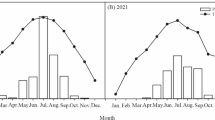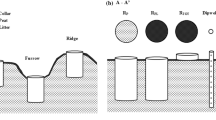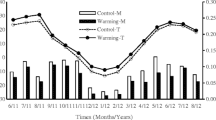Abstract
The effect of land use change from agricultural to short rotation woody crops on soil respiration and its temperature sensitivity is not fully understood. We studied the effect of land use change on soil respiration, in a factorial experiment, 4 years after converting an agricultural field to a Walker poplar (Populus deltoides × Populus × petrowskyana var. Walker) plantation in the boreal region of northeastern Alberta. Overall, total soil respiration was greater in the agricultural plots (planted to alfalfa, Medicago sativa L.) than in the poplar plots. Soil respiration and soil temperature at the 10-cm depth in both land uses had similar seasonal and diurnal variations. The season-long temperature sensitivity (Q10) of daily and nighttime soil respiration in the alfalfa plots was greater than that in the poplar plots, with Q10 values of 5.4 vs. 4.9, respectively. Our data also show that, 4 years after land use conversion, the heterotrophic respiration was smaller in the poplar plots than in the adjacent agricultural plots, indicating potential benefits of plantation establishment in reducing heterotrophic respiration. However, the temperature sensitivity of soil respiration based on monthly nighttime rates, which minimizes the plant phenological influences, was greater in the poplar plantation, suggesting that soil respiration could become greater in the poplar plantation under a future warmer climate. We conclude that establishment of poplar plantations, which are known to have a fast rate of biomass production for long-term carbon storage, may help mitigate climate change by reducing heterotrophic and total soil respiration in the Canadian boreal region, but the long-term implications (e.g., changes in the temperature sensitivity of soil respiration over time) need to be further studied.





Similar content being viewed by others
References
Arevalo CBM, Bhatti JS, Chang SX, Sidders D (2009) Ecosystem carbon stocks and distribution under different land-uses in north central Alberta, Canada. For Ecol Manage 257:1776–1785
Arevalo CBM, Bhatti JS, Chang SX, Jassal RS, Sidders D (2010) Soil respiration in four different land use systems in north central Alberta, Canada. J Geol Res. doi:10.10029/2009jg001006
Arevalo CBM, Bhatti JS, Chang SX, Sidders D (2011) Land use change effects on ecosystem carbon balance: from agricultural to hybrid poplar plantation. Agric Ecosyst Environ 141:342–349
Arevalo CBM, Chang SX, Bhatti JS, Sidders D (2012) Mineralization potential and temperature sensitivity of soil organic carbon under different land uses in the Parkland region of Alberta, Canada. Soil Sci Soc Am J 76:241–251
Balser TC, Wixon DL (2009) Investigating biological control over soil carbon temperature sensitivity. Glob Change Biol 15:2935–2949
Boone RD, Nadelhoffer KJ, Canary JD, Kaye JP (1998) Roots exert a strong influence on the temperature sensitivity of soil respiration. Nature 396:570–572
Bruce JP, Frome M, Haites E, Joanne H, Lal R, Faustian K (1999) Carbon sequestration in soils. J Soil Water Conserv 54:382–389
Carlisle EA, Steenwerth KL, Smart DR (2006) Effects of land use on soil respiration: conversion of oak woodlands to vineyards. J Environ Qual 35:1396–1404
Davidson EA, Belk E, Boone RD (1998) Soil water content and temperature as independent or confounded factors controlling soil respiration in a temperate mixed hardwood forest. Glob Change Biol 4:217–227
Davidson EA, Janssens IA, Luo YQ (2006) On the variability of respiration in terrestrial ecosystems: moving beyond Q(10). Glob Change Biol 12:154–164
DeGryze S, Six J, Paustian K, Morris SJ, Paul EA, Merckx R (2004) Soil organic carbon pool changes following land-use conversions. Glob Change Biol 10:1120–1132
Dixon RK, Brown S, Houghton RA, Solomon AM, Trexler MC, Wisniewski J (1994) Carbon pools and flux of global forest ecosystems. Science 263:185–190
Dominy SWJ, Gilsenan R, McKenney DW, Allen DJ, Hatton T, Koven A, Cary J, Yemshanov D, Sidders D (2010) A retrospective and lessons learned from Natural Resources Canada’s Forest 2020 afforestation initiative. For Chron 86:339–347
Drewitt GB, Black TA, Nesic Z, Humphreys ER, Jork EM, Swanson R, Ethier GJ, Griffis T, Morgenstern K (2002) Measuring forest floor CO2 fluxes in a Douglas-fir forest. Agr For Meteorol 110:299–317
Environment Canada (2004) Canadian climate normals or averages 1971 - 2000 [online]. Available: http://www.climate.weatheroffice.ec.gc.ca/climate_normals/index_e.html
Fang C, Moncrieff JB, Gholz HL, Clark KL (1998) Soil CO2 efflux and its spatial variation in a Florida slash pine plantation. Plant Soil 205:135–146
FAO (2004) Assessing carbon stocks and modeling win-win scenarios of carbon sequestration through land-use changes. FAO, Rome
Gaumont-Guay D, Black TA, Griffis TJ, Barr AG, Jassal RS, Nesic Z (2006) Interpreting the dependence of soil respiration on soil temperature and water content in a boreal aspen stand. Agri For Meteorol 140:220–235
Grunzweig JM, Sparrow SD, Chapin FS (2003) Impact of forest conversion to agriculture on carbon and nitrogen mineralization in subarctic Alaska. Glob Change Biol 64:271–296
Gu LH, Post WM, King AW (2004) Fast labile carbon turnover obscures sensitivity of heterotrophic respiration from soil to temperature: a model analysis. Glob Biogeochem Cycle 18:GB1022
Guo LB, Gifford RM (2002) Soil carbon stocks and land use change: a meta analysis. Glob Change Biol 8:345–360
Hamdi S, Moyano F, Sall S, Bernoux M, Chevallier T (2013) Synthesis analysis of the temperature sensitivity of soil respiration from laboratory studies in relation to incubation methods and soil conditions. Soil Biol Biochem 58:115–126
Hanson PJ, Edwards NT, Garten CT, Andrews JA (2000) Separating root and soil microbial contributions to soil respiration: A review of methods and observations. Biogeochemistry 48:115–146
Henry JD (2002) Canada’s boreal forest. Smithsonian Institute Press, Washington
Hopkins WG (1999) Introduction to Plant Physiology. Second edition. Wiley, Chichester. pp. 107
Houghton RA (1995) Land-use change and the carbon cycle. Glob Change Biol 1:275–287
Janssens IA, Pilegaard K (2003) Large seasonal changes in Q10 of soil respiration in a beech forest. Glob Change Biol 9:911–918
Janssens IA, Dore S, Epron D, Lankreijer H, Buchmann N, Longdoz B, Brossaud J, Montagnani L (2003) Climatic influences on seasonal and spatial differences in soil CO2 efflux. In: Valentini R (ed) Canopy fluxes of energy, water and carbon dioxide of European forests. Springer, Berlin, pp 253–256
Jia XX, Shao MA, Wei XR, Li XZ (2014) Response of soil CO2 efflux to water addition in temperate semiarid grassland in northern China: the importance of water availability and species composition. Biol Fertil Soils 50:839–850
Johnson D, Phoenix GK, Grime JP (2008) Plant community composition, not diversity, regulates soil respiration in grasslands. Biol Let 4:345–348
Karhu K, Auffret MD, Dungait JAJ, Hopkins DW, Prosser JI, Singh BK, Subke JA, Wookey PA, Ågren GI, Sebastià MT, Gouriveau F, Bergkvist G, Meir P, Nottingham AT, Salinas N, Hartley IP (2014) Temperature sensitivity of soil respiration rates enhanced by microbial community response. Nature 513:81–84
Kelting DL, Burger JA, Edwards NT (1998) Estimating root respiration, microbial respiration in the rhizosphere, and root-free soil respiration in forest soils. Soil Biol Biochem 30:961–968
Kirschbaum MUF (2006) The temperature dependence of organic-matter decomposition—still a topic of debate. Soil Biol Biochem 38:2510–2518
Kramer C, Gleixner G (2008) Soil organic matter in soil depth profiles: distinct carbon preferences of microbial groups during carbon transformation. Soil Biol Biochem 40:425–433
Laganiere J, Angers DA, Pare D (2010) Carbon accumulation in agricultural soils after afforestation: a meta-analysis. Glob Change Biol 16:439–453
Lal R (2004) Soil carbon sequestration impacts on global climate change and food security. Science 304:1623–1627
Li Y, Xu M, Zou X, Shi P, Zhang Y (2005) Comparing soil organic carbon dynamics in plantation and secondary forest in wet tropics in Puerto Rico. Glob Change Biol 11:239–248
Lindroth A, Grelle A, Moren AS (1998) Long-term measurements of boreal forest carbon balance reveal large temperature sensitivity. Glob Change Biol 4:443–450
Lü MK, Xie JS, Wang C, Guo JF, Wang MH, Liu XF, Chen YM, Chen GS, Yang YS (2015) Forest conversion stimulated deep soil C losses and decreased C recalcitrance through priming effect in subtropical China. Biol Fertil Soils 51:857–867
Luo YQ, Wan SQ, Hui DF, Wallace LL (2001) Acclimatization of soil respiration to warming in a tall grass prairie. Nature 413:622–625
Menichetti L, Reyes Ortigoza AL, García N, Giagnoni L, Nannipieri P, Renella G (2015) Thermal sensitivity of enzyme activity in tropical soils assessed by the Q10 and equilibrium model. Biol Fertil Soils 51:299–310
Minchin PEH, Lacointe A (2005) New understanding on phloem physiology and possible consequences for modelling long-distance carbon transport. New Phytol 166:771–779
Morris SJ, Bohm S, Haile-Mariam S, Paul EA (2007) Evaluation of carbon accrual in afforested agricultural soils. Glob Change Biol 13:1145–1156
Natural Regions Committee (2006) Natural Regions and Subregions of Alberta. Compiled by Downing DJ and Pettapiece WW. Government of Alberta. Pub. No. T/852
Paul EA, Harris D, Collins HP, Schulthess U, Robertson GP (1999) Evolution of CO2 and soil carbon dynamics in biologically managed, row-crop agroecosystems. Appl Soil Ecol 11:53–65
Paul KI, Polglase PJ, Nyakuengama JG, Khanna PK (2002) Change in soil carbon following afforestation. For Ecol Manage 168:241–257
Phillips CL, Nickerson N, Risk D, Bond BJ (2011) Interpreting diel hysteresis between soil respiration and temperature. Glob Change Biol 17:515–527
Poulton PR, Pye E, Hargreaves PR, Jenkinson DS (2003) Accumulation of carbon and nitrogen by old arable land reverting to woodland. Glob Change Biol 9:942–955
Qi Y, Xu M (2001) Separating the effects of moisture and temperature on soil CO2 efflux in a coniferous forest in the Sierra Nevada mountains. Plant Soil 237:15–23
Raich JW, Tufekcioglu A (2000) Vegetation and soil respiration: Correlations and controls. Biogeochemistry 48:71–90
Rodeghiero M, Cescatti A (2005) Main determinants of forest soil respiration along an elevation/temperature gradient in the Italian Alps. Glob Change Biol 11:1024–1041
Saurette DD, Chang SX, Thomas BR (2008) Land-use conversion effects on CO2 emissions: from agricultural to hybrid poplar plantation. Ecol Res 23:623–633
Savage KE, Davidson EA (2003) A comparison of manual and automated systems for soil CO2 flux measurements: trade-offs between spatial and temporal resolution. J Exp Bot 54:891–899
Serreze MC, Walsh JE, Chapin FS, Osterkamp T, Dyurgerov M, Romanovsky V, Oechel WC, Morison J, Zhang T, Barry RG (2000) Observational evidence of recent change in the northern high-latitude environment. Clim Change 46:159–207
Sheng H, Yang YS, Yang ZJ, Chen GS, Xie JS, Guo JF, Zou SQ (2010) The dynamic response of soil respiration to land-use changes in subtropical China. Glob Change Biol 16:1107–1121
Shi PL, Zhang XZ, Zhong ZM, Ouyang H (2006) Diurnal and seasonal variability of soil CO2 efflux in a cropland ecosystem on the Tibetan Plateau. Agri For Meteorol 137:220–233
Solomon S, Qin D, Manning M, Chen Z, Marquis M, Averyt KB, Tignor M, Miller HL (2007) Climate Change 2007: The Physical Science Basis. Contribution of Working Group I to the Fourth Assessment Report of the Intergovernmental Panel on Climate Change. Cambridge University Press, Cambridge, UK, pp 847–940
Subke JA, Bahn M (2010) On the ‘temperature sensitivity’ of soil respiration: can we use the immeasurable to predict the unknown? Soil Biol Biochem 42:1653–1656
Sun SQ, Bhatti JS, Jassal RS, Chang SX, Arevalo CM, Black TA, Sidders D (2015) Stand age and soil productivity control soil CO2 efflux and soil organic carbon dynamics in hybrid poplar plantations. Soil Sci Soc Am J 79:1638–1649
Tang JW, Baldocchi DD, Xu L (2005) Tree photosynthesis modulates soil respiration on a diurnal time scale. Glob Change Biol 11:1298–1304
Teklay T, Chang SX (2008) Temporal changes in soil carbon and nitrogen storage in a hybrid poplar chronosequence in northern Alberta. Geoderma 144:613–619
Teklay T, Shi Z, Attaeian B, Chang SX (2010) Temperature and substrate effects on C & N mineralization and microbial community function of soils from a hybrid poplar chronosequence. Appl Soil Ecol 46:413–421
Wang C, Yang J, Zhang Q (2006) Soil respiration in six temperate forests in China. Glob Change Biol 12:2103–2114
Wang XG, Zhu B, Gao MR, Wang YQ, Zheng XH (2008) Seasonal variations in soil respiration and temperature sensitivity under three land-use types in hilly areas of the Sichuan Basin. Aus J Soil Res 46:727–734
Xu M, Qi Y (2001) Soil-surface CO2 efflux and its spatial and temporal variations in a young ponderosa pine plantation in northern California. Glob Change Biol 7:667–677
Yemshanov D, Biggs J, McKenney DW, Lempriere T (2012) Effects of permanence requirements on afforestation choices for carbon sequestration for Ontario, Canada. For Policy Econ 14:6–18
Yuste JC, Janssens IA, Carrara A, Ceulemans R (2004) Annual Q(10) of soil respiration reflects plant phenological patterns as well as temperature sensitivity. Glob Change Biol 10:161–169
Acknowledgments
We thank Dan Saurette, Sarah Pattison, Tesfay Teklay, Gary Sargeant, Michelle Marler, Pak Chow, Pete Presant, and others in the Forest Soils laboratory for assistance in the laboratory and field and Dave Kamelchuk at Alberta-Pacific Forest Industries Inc. for assistance in the field. The technical assistance from Professor Andy Black’s group, particularly Zoran Nezic, of the University of British Columbia on the automated soil respiration systems was appreciated. Professor Robert Grant contributed in discussions. We sincerely thank Alberta-Pacific Forest Industries Inc., BIOCAP Canada Foundation, and the Natural Science and Engineering Council of Canada (NSERC) for the financial support for this project. The second author was also partially supported by a scholarship from the University of Alberta. Kangyi Luo assisted in formatting the manuscript. We thank the constructive comments from four anonymous reviewers that substantially improved the quality of an earlier version of this manuscript.
Author information
Authors and Affiliations
Corresponding author
Electronic Supplementary Material
Below is the link to the electronic supplementary material.
ESM 1
(DOCX 74 kb)
Rights and permissions
About this article
Cite this article
Chang, S.X., Shi, Z. & Thomas, B.R. Soil respiration and its temperature sensitivity in agricultural and afforested poplar plantation systems in northern Alberta. Biol Fertil Soils 52, 629–641 (2016). https://doi.org/10.1007/s00374-016-1104-x
Received:
Revised:
Accepted:
Published:
Issue Date:
DOI: https://doi.org/10.1007/s00374-016-1104-x




